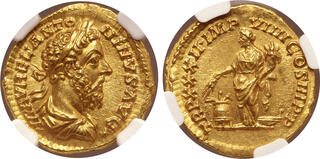| Roma Numismatics Ltd > Auction XXX | Auction date: 21 March 2024 |
| Lot number: 458 Price realized: 22,000 GBP (Approx. 27,869 USD / 25,659 EUR) Note: Prices do not include buyer's fees. | Show similar lots on CoinArchives Find similar lots in upcoming auctions on |
| Lot description: Marcus Aurelius AV Aureus. Rome, AD 177-178. M AVREL▾ANTONINVS▾AVG▾, laureate, draped and cuirassed bust to right / TR P XXXII▾IMP VIIII COS III P ▾P, Annona standing to left, holding cornucopiae and two ears of corn over modius at feet on left; prow to right at feet on right. RIC III 389; C. 957 var. (bust type); BMCRE 771 (same obv. die); Biaggi 905 (this coin); Faces of Power 302 (same obv. die); Calicó 2020 (same dies) corr. (bust type). 7.35g, 20mm, 12h. NGC graded Ch MS 5/5 - 4/5, light mark (#6674257-002). Ex Roma Numismatics Ltd., Auction XXIII, 24 March 2022, lot 996 (hammer: GBP 32,000); Ex Numismatica Ars Classica AG, Auction 119 with Jesús Vico S.A., 6 October 2020, lot 111, then sold with an export licence issued by the government of Spain; Privately purchased from Cayón Numismática, 1981; Ex Leo Biaggi de Blasys Collection; Privately purchased from H. A. Cahn in June 1950. Annona was the divine personification of the grain supply to the city of Rome, a creation of Imperial pseudo-religious propaganda, manifested in iconography and cult practice, but lacking in narrative mythology or a historical tradition of devotion. The Roman government used the term Cura Annonae ("care for the grain supply"), in reference to the import and distribution of grain to the residents of the city of Rome. Rome imported most of the grain consumed by its urban population, estimated to number one million people by the second century AD. Most of this grain was distributed through commercial or non-subsidized channels, but a dole of subsidized or free grain, and later bread, was provided by the government to about 200,000 of the poorer residents of the city of Rome. It has been estimated that each year as much as 60,000,000 modii of grain (about 420,000 tonnes) reached the city, equivalent to approximately 1,200 large vessels containing 50,000 modii (about 350 tonnes) each. The grain ships that sailed principally from Egypt and Africa, and the shipping lanes they travelled were therefore of strategic importance. Whoever controlled the grain supply had an important measure of control over the city of Rome, which was utterly reliant on regular imports. The depiction of Annona with a modius and grain ship on this coin is therefore closely associated with the principate, being one of the most ubiquitous and important manifestations of the emperor's power to care for his people. The date when the Cura Annonae ended is unknown, but it may have lasted even into the 6th century, by which time the population of Rome had greatly declined through famine, war and economic ruin to as little as 100,000. The great machinery of empire that had once spanned all of Europe and sustained the greatest city on earth had been effectively shattered by barbarian migration and subsequent warfare, and with the eventual disappearance of the great grain fleets it would not be until the sixteenth century that vessels of similar tonnages would ply the waters of the Mediterranean again. Estimate: 25000 GBP |  |


